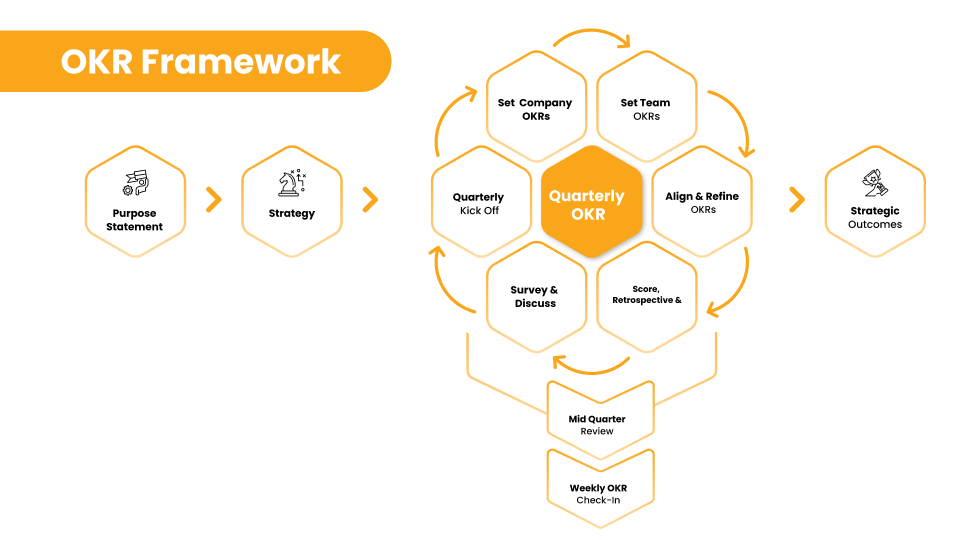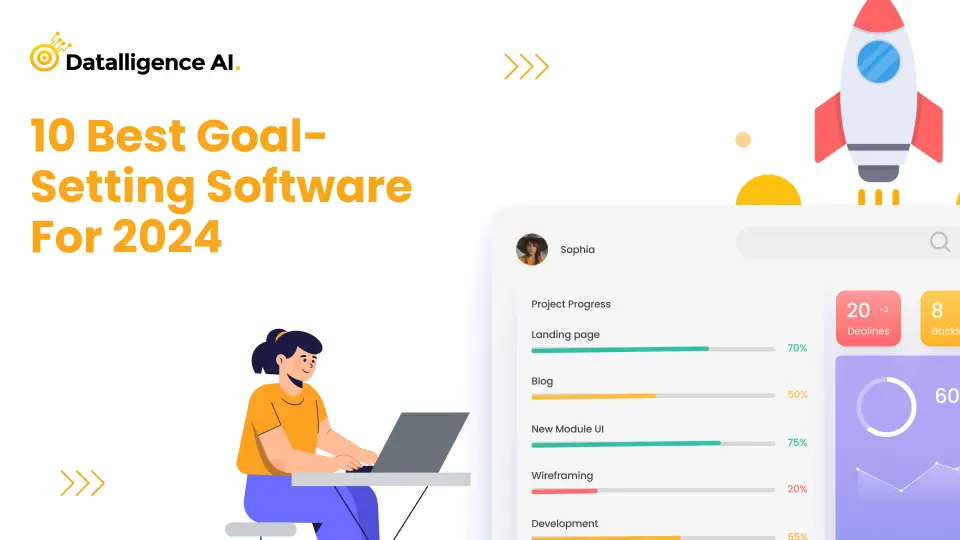Summary: A growth methodology framework, Objective, and key results, (or OKRs) is an effective method of planning and measuring the success of an organization at the individual team level. But when companies apply OKR to an individual team member, they fall short. OKR’s strategic planning method contributes to team goals and adds real value to the company and its customers.
What is OKR?
Objectives and Key Results or OKRs is the most popular framework for teams to plan and measure the success metrics of their work. With OKR planning, the leader of the team at each organization set aspirational goals as objectives,
The objective is what you want to accomplish. The key result is how you’re going to get it done. The objectives are typically farsighted for a longer period. They’re bold and aspirational. The key results are aggressive, but always measurable, time-bound, and limited in number.
But remember OKRs are kept in the middle of the table, not in the corner.
OKRs would only guide you if you’ll perform a weekly check-in, else your OKR planning will be just another approach to unfinished business.
OKR is not like you set the goals and then stuff them away in a drawer and ignore them. Your team leader/ CEO would not like it. If the leader would be ambitious he/she will care and must be watching your goals and cheering them up.
If a leader wants to follow a top to bottom approach in the organization, OKR strategic planning will be a great tool for doing it.
Check out the Datalligence OKR tool now

Quarterly and Annual planning of OKR
OKR is time bounded and needed to be achieved within the desired timeline, else it would be taken casually & it would be an ambiguous goal. Strategic OKR planning needs to be it with numbers, with some plans and boards needed to be set and reported.
OKRs can strongly be breaking your goals into quarters will let you analyze team efforts adapt to the process more easily, and ultimately better hit their goals.
Generally, annual goals are alluring, know why?
Annual OKR or goals are normally like a shooting star ( like a wish), the first goals set at the annual leadership. For example, We need to hit $ 700mill in ARR to be a market leader or we want to be present globally with a 25% increase in the speed of innovation.
Annual goals act as broad guidance and focus on long-term goals. But when OKRs are in a tool and monitored daily- that makes more sense. That doesn’t mean annual goals are not ambitious or timebound but they highlight the issue of tracking progress.
Benefits of Quarterly Planning
1. Greater Flexibility of goals
When goals are quarterly cadence gives your teams more flexibility to adapt to new challenges more easily without making changes to the annual plans.
2. Visible results
Breaking the larger, annual goal into quarterly pieces gives teams more tangible results and makes the OKR planning more strategic, if the goal is not achieved in Q1 it can be modified in Q2 and key results around can be altered easily.
3. New information week to week
Generally, start-up companies that are in the building stage keep on changing their strategies and revamp their entire plans, for that shorter period of plans are helpful to update new key results around.
5 Steps for planning OKRs
Company values play a vital role in planning and rolling out OKR in your organization and guide your team on how to behave to achieve your company goals.
Before planning for OKR, your company values can help you in OKR strategic planning. You can rule out doing things that are inconsistent with your values and encourage everyone in the organization to call out behaviors inconsistent with these Values.
Step 1: Understand the mission and vision of your company
This first step is important for keeping your objectives aligned with the company’s vision statement and overall values. Before rolling out OKR in your organization make sure what values mean to you and your organization. OKR brings a new culture, and new habits if your team is not resistant to change- you might fail OKR adoption.
Step 2: Decide who should lead your OKR
OKR produces leaders, but before introducing OKR in your organization you choose the person you can count on if there is some problem related to your team’s OKRs. Generally, the HR of the company brings OKR into the culture to measure performances and incentives based on the OKR achievement. But a team leader, CEO/investors, and project manager can also be the right fit to lead.
Step 3: Establish a timeline, and priorities before setting up OKRs
Establishing timelines, priorities, capacity, and any other helpful information is done during the planning of OKR. Multiples of priorities disturb your OKR achievement process and slow down growth. Gather all the important & useful information that might be needed in setting OKRs
Step 4: Team develop and set their OKRs
Once leaders have discussed the Company Objectives and jot down them somewhere or fed them in an OKR software or spreadsheets, everyone to see and provide feedback if necessary, it’s time for Teams to create and set their OKRs. When planning your Team OKRs, you should again think of aspirational, quantitative goals that link to the OKRs of top-level management goals. Confirming that your OKRs follow this principle, will give teams a sense of responsibility, focus, and motivation for the quarter.
Step 5: Set up a procedure to track OKRs timely
Tracking OKR is as important as planning and implementing OKR. Check-ins are like a 5th wheel of the car, not visible but a rescuer. Similarly. If check-ins are not done timely, it is likely to lose the value and the potential of your goal.
We recommend using OKR software with intuitive features that will provide you with all the benefits. Tracking progress toward goals shouldn’t be another managerial task to add to your workload.
👉 Make sure the OKR system adds on the valuable benefit that helps you simplify the reporting process. Take a look at our buying guide to help you find the best OKR software for your business in 2022.
What does the OKR process look like?
OKR can be different things to different organizations. For startups, it can be a growth framework or growth strategy. For big companies which are well established, it can be a framework for innovation.
But before considering for OKR process, do you know what employees want and how they can be engaged?
• 70% of employees want more clarity on goals & strategy
• 67% of employees will be more engaged when their individual goals are aligned with corporate goals
• Transparency is the #1 factor contributing to employee happiness
• 70% of employees want to see how their job contributes to the company’s strategy
• 50% want to know better what is expected of them at work
The OKR process looks like this:
1. OKR planning
Identifying the OKR need: Revisiting the vision and mission of the company and aligning the company values with OKR. Before you begin coming up with objectives, decide who should lead your OKR planning discussions. Understand your team’s bandwidth and strengths and accordingly plan for the goals you visualize achieving.
2. OKR Developing
OKRs can drive alignment, encourage cooperation, and hold you more accountable for your own OKRs. Create your OKRs transparently, don’t be a one-man army, share your OKRs with your team and delegate the tasks. You don’t want to hold the responsibilities alone; assign the OKR to one answerable person, so that you as a leader can work on other deliverables that will directly add value to your business.
3. OKRs in action
You’ll want an easy-to-use tool to keep track of your OKRs and progress. You can check out the Datalligence OKR tool for a seamless solution. For OKR strategic planning and action- make sure you choose an actionable OKR tool with enough transparency to roll out into your entire organization.
4. Post-mortem
The last step is to analyze where you stand with your OKRs and slightly like an achievement if you have achieved 20% results of your objective. OKR is an ongoing process, revise them for the next quarter and keep jumping one step at a time. Bring the bottlenecks and solve those problems in sprints with updated OKRs and key results.
Now you know what OKR is and what value it can bring to your organization, you can check OKR examples and learn how to get started.
Your Content Goes Here











